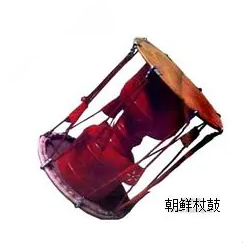The origin of the Korean stick drum
209 views · Organized by 一杯清酒 on 2022-03-14
Korean stick drum stick drum, also known as the Korean long drum. Korean mixed percussion instrument. In Korean, it is called bu. With a long history, unique structure and soft tone, it is often used for singing and dancing accompaniment and instrumental ensemble. Popular in Liaoning, Jilin, Heilongjiang, Inner Mongolia, Hebei and other provinces, especially in Yanbian Korean Autonomous Prefecture in Jilin Province.
At the beginning of the 11th century, the zhanggu was introduced to Korea from the east of my country. According to the "History of Korean Music", the zhanggu was already used in the music of the Tang Dynasty during the Goryeo Wenzong period (1047-1082). The drum system and playing method recorded in the ancient Korean book "Music Learning Guide" are very detailed: "Press: For making stick drums, the waist wood and lacquer cloth are the best shells, followed by magnetism, and tiles are not good. , use irons on both sides. The large surface is made of white raw horse skin, and the small surface is made of raw horse skin. The large surface is beaten with the left hand, which is called a drum; the small surface is hit with a stick with the right hand, which is called a whip; Strike is called double; strike with a stick temporarily to make a shaking sound, called shake. Tang music and local music are used together." The stick drum in South Korea, used for elegant and popular music in the past, was once the music of the "Tang Department" of the court. One of the main musical instruments, it is still widely circulated among the people today. After the Qing Dynasty, the stick drum disappeared in the Central Plains of my country, but it is still widely popular among the Korean folk, and has a new name - long drum according to its shape.

At the beginning of the 11th century, the zhanggu was introduced to Korea from the east of my country. According to the "History of Korean Music", the zhanggu was already used in the music of the Tang Dynasty during the Goryeo Wenzong period (1047-1082). The drum system and playing method recorded in the ancient Korean book "Music Learning Guide" are very detailed: "Press: For making stick drums, the waist wood and lacquer cloth are the best shells, followed by magnetism, and tiles are not good. , use irons on both sides. The large surface is made of white raw horse skin, and the small surface is made of raw horse skin. The large surface is beaten with the left hand, which is called a drum; the small surface is hit with a stick with the right hand, which is called a whip; Strike is called double; strike with a stick temporarily to make a shaking sound, called shake. Tang music and local music are used together." The stick drum in South Korea, used for elegant and popular music in the past, was once the music of the "Tang Department" of the court. One of the main musical instruments, it is still widely circulated among the people today. After the Qing Dynasty, the stick drum disappeared in the Central Plains of my country, but it is still widely popular among the Korean folk, and has a new name - long drum according to its shape.
Involving musical instruments
The stick drum (pinyin: zhàng gǔ), the Korean mixed percussion instrument, also known as the long drum, is called bu in Korean. Popular in Liaoning, Jilin, Heilongjiang, Inner Mongolia, Hebei and other provinces, especially in Yanbian Korean Autonomous Prefecture in Jilin Province.
Guess you like
Organized by 雨童 on 2022-03-21
Bai folk instrumental music mainly includes sanxian music, suona wind and percussion music, cave scripture music, etc. In addition, there are also ancient music and tunes played by bamboo flute, mouth spring, wood leaf and so on.
read >>
Organized by 华夫饼 on 2022-03-14
Fujian stick drum, also known as Fuzhou drum, wolf tent, wolf stick, wolf string, wolf stick drum, wolf singing. Evolved from the two-stick drum in ancient China, it is a traditional percussion instrument in Fujian folk.
read >>
Organized by 未知领地 on 2022-02-14
The stick drum, the Korean mixed percussion instrument, also known as the long drum, is called bu in Korean. Popular in Liaoning, Jilin, Heilongjiang, Inner Mongolia, Hebei and other provinces, especially in Yanbian Korean Autonomous Prefecture in Jilin Province. The timbre of the stick drum is soft, and it is often used for singing and dancing accompaniment and instrumental ensemble. It is a national musical instrument that is deeply loved by the Korean people.
read >>
Hot news
- 01 The handsome guy in 1997 is so advanced in pulling erhu! Netizen: Come and "wash your ears"
- 02 The Simple Difference Between Guqin, Se, and Guzheng
- 03 The difference between the five-stringed lute and the four-stringed lute
- 04 Dulcimer exam and performance repertoire
- 05 The difference between cymbals and cymbals in ethnic musical instruments
 渝公网安备 50010702504639号
渝公网安备 50010702504639号